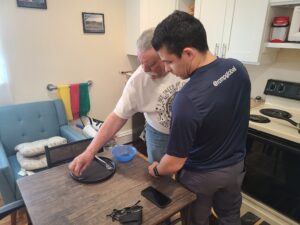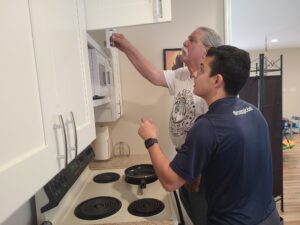Occupational
What Does an Occupational Therapist Do?
An Occupational Therapist treats people throughout the lifespan with injuries, disabilities, or developmental delays using several therapeutic daily activities. They evaluate, plan, organize, and conduct rehabilitative programs that seek to develop or restore important living skills, and improve general independence.
Occupational Therapy and the Pediatric Patient
Services differ a bit based on the population the therapist serves. With the pediatric client, our therapists take of the role of assessing and habilitating children in the following areas
Feeding– The therapist works with children from the basics of toleration of a variety of food textures dues to sensory integration difficulties through the actual process of properly utilizing utensils age appropriately to support proper nutrition.
Self-Care/ Activities of Daily Living– The therapist works with children in the areas of hygiene, toileting, dressing, crawling, walking, skipping, throwing, and catching a ball.
Sensory Integration is a neurological disorder that results from the brain’s inability to integrate, process, and respond to certain information received from the body’s five basic sensory systems. Occupational Therapist are specially trained to use techniques that desensitize or heighten the neurological system to meet the child’s need which helps to organize them and improve focus so that they can learn and participate in functional tasks.
Fine Motor– The therapist works with children to help improve hand eye coordination, grasp, manipulation of their hands and fingers to complete tasks such as snipping with scissors, holding a crayon or pencil, buttoning or zipping clothing.
Upper Extremity Strength, Balance and Coordination– The Occupational Therapist works with children in functional and play tasks to improve these areas so that they can maintain proper alignment and coordination to successful care for themselves and complete age appropriate tasks.
Occupational Therapy and the Patients with Disabilities due to Physical or Neurological Insult
The Occupational Therapist role in Out-Patient Rehabilitation includes:
- Gaining the physical skills needed to use an arm/hand that was affected by a stroke or brain injury.
- Teaching adaptive ways to get washed, dressed and perform homemaking activities.
- Teaching energy conservation techniques so that an individual can continue to perform what they need to do.
- Developing strategies to compensate for cognitive impairments, in order to allow individuals to increase their independence in everyday tasks.
- Teaching joint protection and the use of adaptive devices that will allow individuals with painful joints to continue to engage in their occupations.
Geriatric Occupational Therapy


As we age, the biggest fear is losing our independence. At Seaside Rehab, our mission is to age in place. Our Occupational Therapists work on strength, coordination, and independence in a functional environment. Our facility is equipped with a mock kitchen, bedroom and bathroom so that they can train patients in how to use adaptive equipment and safety techniques to live their best lives on their terms.
Assisting Employees at Work
Our Occupational Therapists can also help to design functional work environments. They evaluate the workspace and recommend modifications. In some instances, they will meet with a patient’s employer to collaborate on the essential modifications to that individual’s work environment or schedule.
